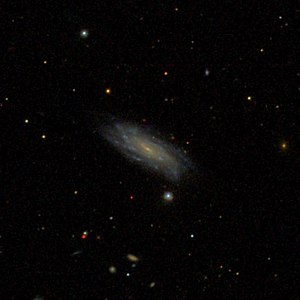NGC 4588
| Galaxy NGC 4588 |
|
|---|---|

|
|
| SDSS recording | |
| AladinLite | |
| Constellation | Virgin |
|
Position equinox : J2000.0 , epoch : J2000.0 |
|
| Right ascension | 12 h 38 m 45.4 s |
| declination | + 06 ° 46 ′ 05 ″ |
| Appearance | |
| Morphological type | SBc |
| Brightness (visual) | 14.3 mag |
| Brightness (B-band) | 15.0 mag |
| Angular expansion | 1.3 '× 0.4' |
| Position angle | 57 ° |
| Surface brightness | 13.7 mag / arcmin² |
| Physical data | |
| Affiliation | Virgo cluster (??) |
| Redshift | 0.018713 ± 0.000010 |
| Radial velocity | 5610 ± 3 km / s |
|
Stroke distance v rad / H 0 |
(248 ± 17) · 10 6 ly (75.9 ± 5.3) Mpc |
| history | |
| discovery | William Herschel |
| Discovery date | April 13, 1784 |
| Catalog names | |
| NGC 4588 • UGC 7810 • PGC 42277 • CGCG 042-189 • MCG + 01-32-124 • 2MASX J12384531 + 0646042 • VCC 1772 • GC 3126 • H III 98 • GALEX ASC J123845.45 + 064603.7 • LEDA 42277 | |
NGC 4588 is a barred spiral galaxy of the Hubble type SBc in the constellation Virgo north of the ecliptic . It is estimated to be 248 million light years from the Milky Way and about 95,000 light years in diameter. The galaxy is listed as a member of the Virgo galaxy cluster under catalog number VVC 1772 , but it is too far away for that.
The galaxies NGC 4570 , IC 3521 , IC 3576 , IC 3591 are located in the same area of the sky .
The object was on 13 April 1784 by William Herschel discovered
